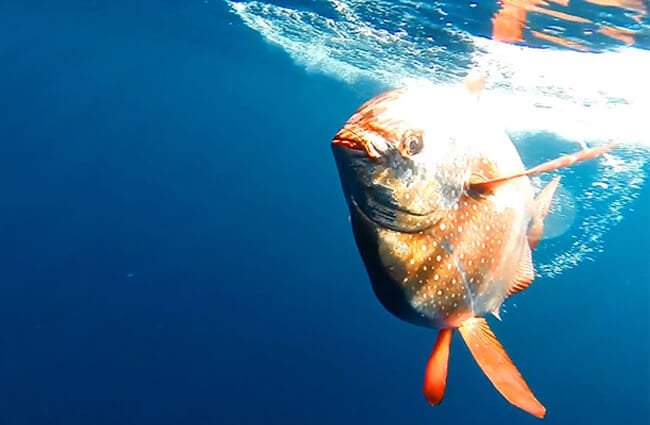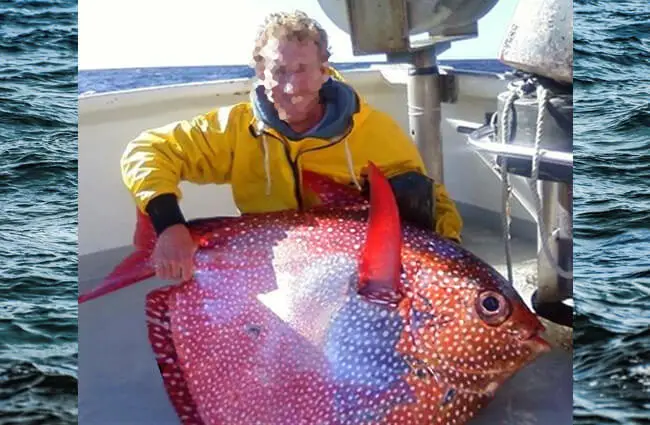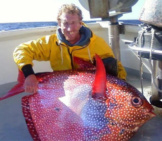People refer to several different species as Moon Fish. For our purposes, we will focus on Lampris guttatus, also known as the opah, kingfish, and sunfish. Researchers believe that several different species exist, though they only currently recognize two species. Read on to learn about the Moon Fish.
Description of the Moon Fish
You simply cannot mistake this fish for any other. It has a large, almost circular, laterally compressed body. Laterally compressed fish have tall bodies with narrow sides. Their scales have a light orange coloration with white spots. Each of their fins has a vibrant orange coloration.
These fish can reach impressive sizes. Some reach over 6 ft. long and up to 600 lbs. or more.
Interesting Facts About the Moon Fish
This vibrant fish is imposing to say the least. Learn more about what makes this species so unique, below.
- Endothermic – Perhaps the most interesting trait of this fish is its vascular system. Unlike most fish, which have a cold-blooded system, this fish is actually warm-blooded, or endothermic. This means that it can regulate its own body temperature.
- Warm Advantage – Their ability to keep their bodies warm provides an important advantage. When hunting in cold, deep waters, these fish can move much faster than most animals in that depth. This allows them to catch prey and out-compete other predators.
- Commercial Use – People frequently catch this species commercially as a source of food. They eat the meat of this fish frequently in Hawaii.
- Different Cuts – Different parts of this fish have different colored flesh when prepared as sushi or sashimi. The meat along the back has an orange color, like salmon. The belly meat has a pink coloration. Finally, the cheeks have dark red coloration, similar to tuna.
Habitat of the Moon Fish
This species lives in the open ocean, or pelagic habitats. It ranges in waters about 160 to 1,640 ft. beneath the surface. During the night, the fish migrate vertically to warmer waters. In the daytime, the migrate deeper to hunt for prey in the cool waters.
Distribution of the Moon Fish
These fish have an extremely wide range. They live throughout much of the oceans of the Northern Hemisphere. You can find this fish throughout most of the Atlantic Ocean.
They also live throughout the northern Pacific Ocean. They range from the deep waters off the coast of western North America to Hawaii, and across to the coast of eastern Asia.
Diet of the Moon Fish
This predatory species is carnivorous, and eats other animals. Its primary prey is small fish, squid, cuttlefish, krill, and more. Despite their large size, they primarily feed on smaller organisms, as their jaws are quite small and toothless.
Moon Fish and Human Interaction
Humans target this fish commercially as a source of food in some regions. In some areas, like Hawaii, people eat this fish quite frequently. Commercial fishing, along with pollution, place some pressure on the species. However, their populations have stable numbers and the IUCN lists them as Least Concern.
Domestication
Humans have not domesticated this fish in any way.
Does the Moon Fish Make a Good Pet
You absolutely could not keep this fish as a pet. They live in deep waters and grow much too large to keep in a home aquarium.
Moon Fish Care
People do not keep this species in aquariums. Aquariums cannot easily house this species because it grows so large and lives primarily in deep waters. They cannot properly replicate the natural habitat of the species.
Behavior of the Moon Fish
Researchers believe that this fish lives a primarily solitary life. However, it does occasionally swim with schools of tuna and similar fish. It performs daily migrations through the water column. During the day it swims in shallow, warm water. At night, it swims deeper to hunt for prey in cold waters.
Reproduction of the Moon Fish
Researchers know little about the breeding habits of this species. Spawning likely occurs seasonally. Females release their eggs and the males fertilize them outside of the body. The eggs hatch into planktonic larvae which look nothing like the adult fish. The slender larvae quickly grow and morph into a miniature version of the adults.

![King Fish caught in Naples, Italy King Fish caught in Naples, Italy Photo by: [public domain]](https://animals.net/wp-content/uploads/2020/01/Moon-Fish-2-650x425.jpg)
![A beautiful photo of a Moon Fish under water A beautiful photo of a Moon Fish under waterPhoto by: Ralph Pace, NOAA [public domain]](https://animals.net/wp-content/uploads/2020/01/Moon-Fish-3-650x425.jpg)

![Fisherman showing off his large catch – a Moon Fish Fisherman showing off his large catch – a Moon Fish Photo by: Unknown (NOAA Fisheries) [Public domain]](https://animals.net/wp-content/uploads/2020/01/Moon-Fish-1-650x425.jpg)

![King Fish caught in Naples, Italy King Fish Caught In Naples, Italy Photo By: [Public Domain]](https://animals.net/wp-content/uploads/2020/01/Moon-Fish-2-162x141.jpg)
![A beautiful photo of a Moon Fish under water A Beautiful Photo Of A Moon Fish Under Waterphoto By: Ralph Pace, Noaa [Public Domain]](https://animals.net/wp-content/uploads/2020/01/Moon-Fish-3-162x141.jpg)

![Fisherman showing off his large catch – a Moon Fish Fisherman Showing Off His Large Catch – A Moon Fish Photo By: Unknown (Noaa Fisheries) [Public Domain]](https://animals.net/wp-content/uploads/2020/01/Moon-Fish-1-162x141.jpg)

![Red Angus Closeup of a beautiful Red Angus cowPhoto by: U.S. Department of Agriculture [pubic domain]https://creativecommons.org/licenses/by/2.0/](https://animals.net/wp-content/uploads/2020/03/Red-Angus-4-238x178.jpg)












![Red Angus Closeup of a beautiful Red Angus cowPhoto by: U.S. Department of Agriculture [pubic domain]https://creativecommons.org/licenses/by/2.0/](https://animals.net/wp-content/uploads/2020/03/Red-Angus-4-100x75.jpg)

